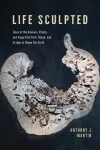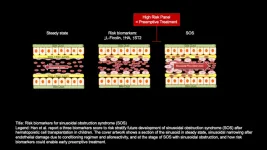(Press-News.org) With the world’s first exascale supercomputing system now open to full user operations, research teams are harnessing Frontier’s power and speed to tackle some of the most challenging problems in modern science.
The HPE Cray EX system at the Department of Energy’s Oak Ridge National Laboratory debuted in May 2022 as the fastest computer on the planet and first machine to break the exascale barrier at 1.1 exaflops, or 1.1 quintillion calculations per second. That’s more calculations per second than every human on Earth could perform in four years.
Frontier remains in the number one spot on the May 2023 TOP500 rankings, with an updated HPL, or high-performance Linpack, score of 1.194 exaflops. The increase of .092 exaflops, or 92 petaflops, is equivalent to the eighth most powerful supercomputer in the world on the TOP500 List. Engineers at the Oak Ridge Leadership Computing Facility, which houses Frontier and its predecessor Summit, expect that Frontier’s speeds could ultimately top 1.4 exaflops, or 1.4 quintillion calculations per second.
In addition to the updated HPL number, the Frontier team has improved the High-Performance Linpack-Mixed Precision Benchmark, HPL-MxP, to nearly 10 EF. Frontier’s HPL-MxP performance is now 9.950 EF, or 9.95 quintillion flops per second improved from 7.9 exaflops in November 2023.
“Frontier represents the culmination of more than a decade of hard work by dedicated professionals from across academia, private business and the national laboratory complex through the Exascale Computing Project to realize a goal that once seemed barely possible,” said Doug Kothe, ORNL’s associate laboratory director for computing and computational sciences. “This machine will shrink the timeline for discoveries that will change the world for the better and touch everyone on Earth.”
Exascale computing’s promise rests on the ability to synthesize massive amounts of data into detailed simulations so complex that previous generations of computers couldn’t process the calculations. The faster the computer, the more possibilities and probabilities can be plugged into the simulation to be tested against what’s already known. The process helps researchers target their experiments and fine-tune designs while saving the time and expense of real-world testing, producing results that are ready to be validated.
“I don’t think we can overstate the impact Frontier promises to make for some of these studies,” said Justin Whitt, the OLCF’s director. “The science that will be done on this computer will be fundamentally different from what we have done before with computation. Our early research teams have already begun exploring fundamental questions about everything from nuclear fusion to forecasting earthquakes to building a better combustion engine.”
Some of the studies underway on Frontier include:
ExaSMR: Led by ORNL’s Steven Hamilton, this study seeks to cut out the long timelines and high front-end costs of advanced nuclear reactor design and use exascale computing power to simulate modular reactors that would not only be smaller but also safer, more versatile and customizable to sizes beyond the traditional huge reactors that power cities.
Exascale Atomistic Capability for Accuracy, Length and Time (EXAALT): This molecular dynamics study, led by Danny Perez of Los Alamos National Laboratory, seeks to transform fundamental materials science for energy by using exascale computing speeds to enable vastly larger, faster and more accurate simulations for such applications as nuclear fission and fusion.
Combustion PELE: This study, named for the Hawaiian goddess of fire and led by Jacqueline Chen of Sandia National Laboratories, is designed to simulate the physics inside an internal combustion engine in pursuit of developing cleaner, more efficient engines that would reduce carbon emissions and conserve fossil fuels.
Whole Device Model Application (WDMApp): This study, led Amitava Bhattacharjee of Princeton Plasma Physics Laboratory, is designed to simulate the magnetically confined fusion plasma – a boiling stew of charged nuclear particles hotter than the sun – necessary for the contained reactions to power nuclear fusion technologies for energy production.
WarpX: Led by Jean-Luc Vay of Lawrence Berkeley National Laboratory, this study seeks to simulate smaller, more versatile plasma-based particle accelerators, which would enable scientists to design particle accelerators for many applications from radiation therapy to semiconductor chip manufacturing and beyond. The team’s work won the Association of Computing Machinery’s 2022 Gordon Bell Prize, which recognizes outstanding achievement in high-performance computing.
ExaSky: This study, led by Salman Habib of Argonne National Laboratory, seeks to expand the size, scope and accuracy of simulations for complex cosmological phenomena, such as dark energy and dark matter, to uncover new insights into the dynamics of the universe.
EQSIM: Led by LBNL’s David McCallen, this study is designed to simulate the physics and tectonic conditions that cause earthquakes to enable assessment of areas at risk.
Energy Exascale Earth System Model (E3SM): This study, led by Sandia’s Mark Taylor, seeks to enable more accurate and detailed predictions of climate change and its effect on the national and global water cycle by simulating the complex interactions between the large-scale, mostly 2D motions of the atmosphere and the smaller, mostly 3D motions that occur in clouds and storms.
Cancer Distributed Learning Environment (CANDLE): Led by Argonne’s Rick Stevens, this study seeks to develop predictive simulations that could help identify and streamline trials for promising cancer treatments, reducing years of lengthy, expensive clinical studies.
“We’ve been carefully fine-tuning Frontier for the past year, and these teams have been our test pilots, helping us see what heights we can reach,” said Bronson Messer, OLCF’s director of science at ORNL. “We’ve just begun to discover where exascale can take us.”
Frontier is an HPE-Cray EX system with more than 9,400 nodes, each equipped with a third-generation AMD EPYC CPU and four AMD Instinct MI250X graphics processing units, or GPUs. The OLCF is a DOE Office of Science user facility.
UT-Battelle manages ORNL for DOE’s Office of Science, the single largest supporter of basic research in the physical sciences in the United States. DOE’s Office of Science is working to address some of the most pressing challenges of our time. For more information, visit https://energy.gov/science. -- Matt Lakin, ORNL
END
Early Frontier users seize exascale advantage, grapple with grand scientific challenges
2023-05-22
ELSE PRESS RELEASES FROM THIS DATE:
Researchers modify drug to enter cells and treat pain
2023-05-22
Altering the chemical properties of an anti-nausea drug enables it to enter an interior compartment of the cell and provide long-lasting pain relief, according to a new study led by researchers at NYU College of Dentistry’s Pain Research Center.
The study, published in the Proceedings of the National Academy of Sciences (PNAS), illustrates how pain signaling occurs inside cells rather than at the surface, highlighting the need for drugs that can reach receptors within cells.
G protein-coupled receptors (GPCRs) are a large ...
Ozone treaty is delaying first ice-free Arctic summer
2023-05-22
A 1987 global deal to protect the ozone layer is delaying the first ice-free Arctic summer by up to 15 years, new research shows.
The Montreal Protocol – the first treaty to be ratified by every United Nations country – regulates nearly 100 man-made chemicals called ozone-depleting substances (ODSs).
While the main aim was to preserve the ozone layer, ODSs are also potent greenhouse gases, so the deal has slowed global warming.
The new study shows the effects of this include delaying the first ice-free ...
Montreal protocol is delaying first ice-free Arctic summer
2023-05-22
New York, NY—May 22, 2023—When scientists discovered a hole over Antarctica in 1985, countries across the globe got together and wrote a treaty designed to protect the ozone layer, which shields the Earth--and us--from harmful levels of ultraviolet radiation. The resulting Montreal Protocol, the only United Nations treaty ratified by every country in the world, was signed in 1987 and entered into effect in 1989, when little was known about its impact on the global climate. Its purpose was to reduce atmospheric concentrations of ozone-depleting substances (ODSs), materials ...
Targeting Phage Therapy World Congress will bring Phage Therapy up to another level with more than 70 communications
2023-05-22
The 6th World Congress on Targeting Phage Therapy 2023, being held on June 1-2 in Paris, will include more than 70 communications highlighting the most recent advances in phage and phage therapy.
150+ attendees will gather to discuss the future potential of phage therapy. The most strategic question to discuss is: “how to bring phage therapy up to a new level?”.
Targeting Phages 2023 will address how phages play a strategic role to combat infection and antibiotic resistance. A special session ...
A brand new, shiny CAR design
2023-05-22
Immunotherapy is rapidly becoming a well-founded form of cancer treatment as it employs and strengthens a patient’s immune system to attack tumors.
Chimeric antigen receptor (CAR) T cells – genetically altered T cells used in immunotherapy that can locate and destroy cancer cells – show great promise. Yet they still struggle in broader applications, particularly in attacking non-tumor cells and persistence in killing tumor cells.
Natasa Miskov-Zivanov, principal investigator and assistant professor of electrical and computer engineering at the University of Pittsburgh Swanson School of Engineering, received a $299,986 EAGER ...
A new map reveals the complicated world in which cells seek to repair damaged DNA
2023-05-22
Writing in the May 22, 2023 issue of Cell Systems, a diverse team of scientists, led by researchers at University of California San Diego School of Medicine, have produced a novel map that depicts the human body’s enormously complicated and highly evolved system for addressing and repairing DNA damage — a cause and consequence of many diseases.
Damage to DNA and replication errors caused by stress and other factors play a major role in disease, and are a hallmark of cancer and other afflictions. To maintain the ...
What constitutes a paradigm shift? An olive shrub’s mating system as a case study of Kuhn’s theory
2023-05-22
Philosopher Thomas Kuhn’s influential theory of how scientific knowledge is built introduced the term “paradigm shift” to explain a transformation of a field’s ideas and methods. “A Paradigm Shift, or a Paradigm Adjustment? The Evolution of the Oleaceae Mating System as a Small-Scale Kuhnian Case Study,” a new paper published in The Quarterly Review of Biology, seeks to apply this analytical framework to a small controversy in population biology: the mating system of the shrub Phillyrea angustifolia.
Traditional theory states that the sex ratio of a population should be 1:1 male to female (or ...
New book eyes Earth's excavators, from microbes to elephants and dinosaurs
2023-05-22
The ordinary person looks at Georgia’s Stone Mountain and sees a solid, unmovable monolith. Emory University paleontologist Anthony Martin, who thinks in geologic time, sees something more akin to a giant sugar cube.
Ever since the crystalized mass of igneous-born minerals rose from deep underground, pushed by the upwelling of magma that formed the Blue Ridge Mountains around 350 million years ago, the giant rock’s flanks have faced continuous assault — and not just from weather and water.
Stone Mountain “is fighting a battle against life, and life is winning,” Martin writes ...
Does hydrocortisone improve treatment of septic shock?
2023-05-22
Sepsis is a global health priority affecting 55 million patients worldwide and causing 11 million deaths annually. Treatment for sepsis may include prompt recognition, source control, antibiotics, fluids, vasopressors, and adjunctive therapies. Corticosteroids have been evaluated as adjunctive therapy for septic shock for more than 50 years. Despite this substantive body of research, uncertainty persists about the effects of corticosteroids on mortality.
In a study publishing May 22, 2023 in the New England Journal of Medicine: ...
Risk biomarkers could predict serious side effect of stem cell transplant
2023-05-22
Doctors are one step closer to having a risk biomarker to alert them to which of their pediatric stem cell transplant patients are likely to experience a potentially deadly side effect called sinusoidal obstruction syndrome (SOS).
A team led by MUSC Hollings Cancer Center researcher Sophie Paczesny, M.D., Ph.D., published the results of its biomarker study in JCI Insight this month.
There is a drug, defibrotide, approved to treat SOS. Paczesny hopes the results of the biomarker study will encourage defibrotide’s manufacturer to conduct a multicenter clinical trial testing ...






